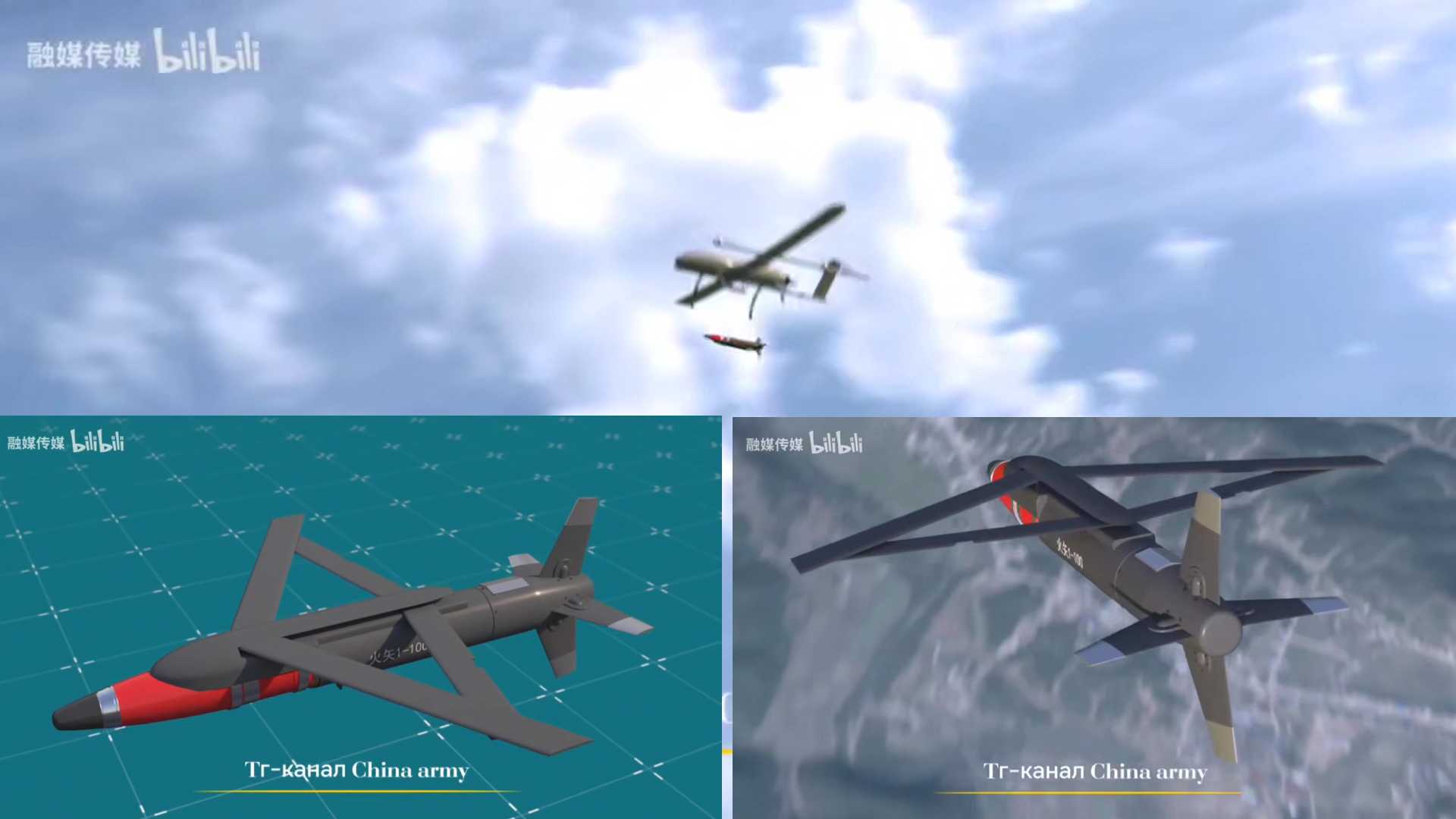China develops new drone-launched glide bomb similar to Russian UMPK kit with 65 kilometer range

{loadposition bannertop}
{loadposition sidebarpub}
As reported by China3army on March 29, 2025, China has developed a new modular glide and correction unit for the HuoShi 1-130 glide bomb. The system was designed by Henan Unmanned Intelligent Equipment Co., Ltd. and is intended for deployment on unmanned aerial vehicles. Depending on the release speed and altitude, the bomb can glide between 6 and 65 kilometers. The HuoShi 1-130 is equipped with an electronic fuse configurable for airburst detonation and features a datalink that allows automatic target coordinate input from small reconnaissance drones operating along the line of contact. The guidance system integrates Beidou satellite navigation with geomagnetic and inertial navigation.Follow Army Recognition on Google News at this link
Such glide bomb kits provide a cost-effective means of enhancing air-to-ground capabilities across multiple platforms, including drones. (Picture source: Telegram/china3army)
This development is comparable to Russia’s UMPK (Universal Gliding and Correction Module), which has been in use since early 2023 to convert Soviet-era unguided bombs into precision-guided munitions. UMPK kits consist of external modular systems with folding wings, tail surfaces, and an onboard guidance system including a Kometa-M satellite antenna, inertial measurement units, and thermal batteries. They are mechanically strapped to bombs at airfields, without requiring structural modification or factory-level retrofit. Guidance is performed through GPS/GLONASS and inertial systems, and the release process includes pre-set coordinates via the aircraft’s SVP-24 bomb trajectory computer. After deployment, the wings unfold, and the guidance module provides mid-course corrections.
UMPK-equipped bombs have been used extensively by Russian forces in Ukraine, including with FAB-250, FAB-500, FAB-1500, and FAB-3000 general-purpose high-explosive bombs. Variants also exist for ODAB-500 and ODAB-1500 thermobaric bombs, RBK-500 cluster bombs, and at least one usage with the three-ton FAB-3000 was officially acknowledged in July 2024. A thermobaric bomb modified with the UMPK kit was shown in Russian Ministry of Defense footage in April 2024, and footage of a FAB-1500M54 bomb equipped with the guidance system was released during a visit by the Russian Minister of Defense to the Tactical Missiles Corporation in January 2024.
In November 2023, Conflict Armament Research analyzed recovered UMPK components and noted the integration of a SMART navigation controller, Kometa satellite navigation unit, dual thermal batteries, wing deployment mechanisms, and servomotors for aerodynamic control. By March 2024, reports from Ukrainian sources noted a case in which a UMPK-equipped FAB-500 bomb detonated approximately five hours after release, potentially indicating use of a delayed fuse or self-destruct mechanism. The glide time from release to impact typically ranges between five and seven minutes. The guidance system is optimized for fixed targets, and the bombs are primarily released from altitudes between 1 and 12 kilometers at speeds of 900 to 950 kilometers per hour. From 10 kilometers altitude, the glide range is approximately 55 kilometers; from 12 kilometers, it increases to about 60 kilometers.
The Russian UMPK is reported to be used in areas 35 to 50 kilometers from the frontline to stay outside most Ukrainian air defense coverage. Ukrainian assessments indicate that Russia releases approximately 3,500 UMPK-equipped bombs per month. The guidance kits are reported to cost approximately 2 million rubles, or around 24,460 USD. The guidance precision is generally within 8 to 15 meters under optimal satellite navigation conditions. The destructive radius can reach up to 140 meters for soft targets. Due to the lack of propulsion systems, these bombs emit no thermal signature and travel at high speeds, reducing the effectiveness of air defense systems such as the Buk-M1.
A new Russian system, the UMPB D-30SN, was identified in March 2024 through wreckage recovered in Ukraine. It integrates a FAB-250 warhead with a jet engine, fuel tank, control surfaces, and guidance systems, allowing for extended range. Russian sources report it can be launched from Su-34 aircraft and from ground-based Tornado-S multiple launch rocket systems. A photo published in May 2024 showed four UMPB bombs being released from a Su-34, with the estimated range reaching up to 90 kilometers. In October 2024, components from a UMPB were discovered in the wreckage of an S-70 UAV shot down by Russian forces, suggesting UAV-based delivery.
In response, Ukraine initiated its own program to develop a UMPK equivalent. Ukrainian Air Force Commander Serhii Golubtsov confirmed development efforts in June 2024. Ukrainian footage released in August showed a Su-24M deploying a guided bomb featuring cruciform control fins and a potential propulsion nozzle. Ukrainian electronic warfare is reported to degrade Russian bomb accuracy, forcing multiple UMPK bombs—up to 8–16 per target—to achieve effective strikes.
China’s earlier developments include the LS series, produced by Luoyang Optoelectro Technology Development Center. The LS-6, revealed in 2006, is a modular kit featuring folding wings, inertial and satellite guidance, and optional laser or scene-matching terminal guidance. Variants exist for 50, 100, 250, and 500 kg warheads, with ranges of up to 65 km for the 500 kg version. The LS-6’s turbojet-assisted variant increases this to 300 km. The LS series is designed to be compatible with a range of aircraft and uses the GJV289A interface, similar to the MIL-STD-1553B.
The United States’ JDAM system, in service since 1999, serves a similar function by converting unguided bombs into precision-guided munitions. JDAM guidance kits consist of GPS-aided inertial navigation, tail control surfaces, and optional terminal seekers. JDAM-ER kits extend the range to over 72 km with folding wings. Ukraine has received JDAM and JDAM-ER kits and has used them operationally from Su-27 and MiG-29 aircraft. Ukrainian forces have reportedly used JDAMs against command posts, including in Tetkino, Russia, and in Bakhmut. All these systems are designed to increase the operational flexibility of existing warhead stockpiles by enabling longer-range, more accurate attacks from beyond the range of most surface-to-air missile systems. Despite limitations—such as dependency on satellite signals and inability to strike moving targets—such glide bomb kits provide a cost-effective means of enhancing air-to-ground capabilities across multiple platforms.

{loadposition bannertop}
{loadposition sidebarpub}
As reported by China3army on March 29, 2025, China has developed a new modular glide and correction unit for the HuoShi 1-130 glide bomb. The system was designed by Henan Unmanned Intelligent Equipment Co., Ltd. and is intended for deployment on unmanned aerial vehicles. Depending on the release speed and altitude, the bomb can glide between 6 and 65 kilometers. The HuoShi 1-130 is equipped with an electronic fuse configurable for airburst detonation and features a datalink that allows automatic target coordinate input from small reconnaissance drones operating along the line of contact. The guidance system integrates Beidou satellite navigation with geomagnetic and inertial navigation.
Follow Army Recognition on Google News at this link
Such glide bomb kits provide a cost-effective means of enhancing air-to-ground capabilities across multiple platforms, including drones. (Picture source: Telegram/china3army)
This development is comparable to Russia’s UMPK (Universal Gliding and Correction Module), which has been in use since early 2023 to convert Soviet-era unguided bombs into precision-guided munitions. UMPK kits consist of external modular systems with folding wings, tail surfaces, and an onboard guidance system including a Kometa-M satellite antenna, inertial measurement units, and thermal batteries. They are mechanically strapped to bombs at airfields, without requiring structural modification or factory-level retrofit. Guidance is performed through GPS/GLONASS and inertial systems, and the release process includes pre-set coordinates via the aircraft’s SVP-24 bomb trajectory computer. After deployment, the wings unfold, and the guidance module provides mid-course corrections.
UMPK-equipped bombs have been used extensively by Russian forces in Ukraine, including with FAB-250, FAB-500, FAB-1500, and FAB-3000 general-purpose high-explosive bombs. Variants also exist for ODAB-500 and ODAB-1500 thermobaric bombs, RBK-500 cluster bombs, and at least one usage with the three-ton FAB-3000 was officially acknowledged in July 2024. A thermobaric bomb modified with the UMPK kit was shown in Russian Ministry of Defense footage in April 2024, and footage of a FAB-1500M54 bomb equipped with the guidance system was released during a visit by the Russian Minister of Defense to the Tactical Missiles Corporation in January 2024.
In November 2023, Conflict Armament Research analyzed recovered UMPK components and noted the integration of a SMART navigation controller, Kometa satellite navigation unit, dual thermal batteries, wing deployment mechanisms, and servomotors for aerodynamic control. By March 2024, reports from Ukrainian sources noted a case in which a UMPK-equipped FAB-500 bomb detonated approximately five hours after release, potentially indicating use of a delayed fuse or self-destruct mechanism. The glide time from release to impact typically ranges between five and seven minutes. The guidance system is optimized for fixed targets, and the bombs are primarily released from altitudes between 1 and 12 kilometers at speeds of 900 to 950 kilometers per hour. From 10 kilometers altitude, the glide range is approximately 55 kilometers; from 12 kilometers, it increases to about 60 kilometers.
The Russian UMPK is reported to be used in areas 35 to 50 kilometers from the frontline to stay outside most Ukrainian air defense coverage. Ukrainian assessments indicate that Russia releases approximately 3,500 UMPK-equipped bombs per month. The guidance kits are reported to cost approximately 2 million rubles, or around 24,460 USD. The guidance precision is generally within 8 to 15 meters under optimal satellite navigation conditions. The destructive radius can reach up to 140 meters for soft targets. Due to the lack of propulsion systems, these bombs emit no thermal signature and travel at high speeds, reducing the effectiveness of air defense systems such as the Buk-M1.
A new Russian system, the UMPB D-30SN, was identified in March 2024 through wreckage recovered in Ukraine. It integrates a FAB-250 warhead with a jet engine, fuel tank, control surfaces, and guidance systems, allowing for extended range. Russian sources report it can be launched from Su-34 aircraft and from ground-based Tornado-S multiple launch rocket systems. A photo published in May 2024 showed four UMPB bombs being released from a Su-34, with the estimated range reaching up to 90 kilometers. In October 2024, components from a UMPB were discovered in the wreckage of an S-70 UAV shot down by Russian forces, suggesting UAV-based delivery.
In response, Ukraine initiated its own program to develop a UMPK equivalent. Ukrainian Air Force Commander Serhii Golubtsov confirmed development efforts in June 2024. Ukrainian footage released in August showed a Su-24M deploying a guided bomb featuring cruciform control fins and a potential propulsion nozzle. Ukrainian electronic warfare is reported to degrade Russian bomb accuracy, forcing multiple UMPK bombs—up to 8–16 per target—to achieve effective strikes.
China’s earlier developments include the LS series, produced by Luoyang Optoelectro Technology Development Center. The LS-6, revealed in 2006, is a modular kit featuring folding wings, inertial and satellite guidance, and optional laser or scene-matching terminal guidance. Variants exist for 50, 100, 250, and 500 kg warheads, with ranges of up to 65 km for the 500 kg version. The LS-6’s turbojet-assisted variant increases this to 300 km. The LS series is designed to be compatible with a range of aircraft and uses the GJV289A interface, similar to the MIL-STD-1553B.
The United States’ JDAM system, in service since 1999, serves a similar function by converting unguided bombs into precision-guided munitions. JDAM guidance kits consist of GPS-aided inertial navigation, tail control surfaces, and optional terminal seekers. JDAM-ER kits extend the range to over 72 km with folding wings. Ukraine has received JDAM and JDAM-ER kits and has used them operationally from Su-27 and MiG-29 aircraft. Ukrainian forces have reportedly used JDAMs against command posts, including in Tetkino, Russia, and in Bakhmut. All these systems are designed to increase the operational flexibility of existing warhead stockpiles by enabling longer-range, more accurate attacks from beyond the range of most surface-to-air missile systems. Despite limitations—such as dependency on satellite signals and inability to strike moving targets—such glide bomb kits provide a cost-effective means of enhancing air-to-ground capabilities across multiple platforms.





